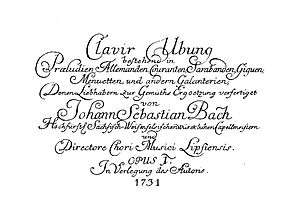Galanterie
The term galanteries is sometimes used for movements in the Baroque dance suite whose inclusion is variable, unlike the fixed core of allemande, courante, sarabande and gigue.[1] These pieces usually follow the sarabande.[2]

In early 18th-century Germany galanterien referred to any fashionable piece and later came to connote out-of-dateness. The narrower use described above seems to originate with a reading of Johann Sebastian Bach's title page description of his keyboard Partitas, "Clavier Übung, bestehend in Präludien, Allemanden, Couranten, Sarabanden, Giguen, Menuetten, und anderen Galanterien", in which it appears to be paired with minuets, whose place is often taken in Bach's suites by gavottes, bourrées, passepieds or other movements.[3][4]
Examples of common galanteries include:
See also
- Galant
- Galante music
- Sonatas and partitas for solo violin (Bach)
References
- Don Michael Randal, compiler: Harvard Concise Dictionary of Music, 1978
- The Baroque Suite at http://www.jacaranda-music.com
- Root, Deane L., ed. (2001). "Galanterie (Ger.)". The New Grove Dictionary of Music and Musicians. Oxford University Press. The unsigned article looks askance at the specialized usage, without citing examples: "whereas in reality the word seems to be used as a modish, slightly deprecatory reference to all the pieces in the collection."
- "Galanterie" in the encyclopedic Oxford Composer Companions J. S. Bach, ed. Malcolm Boyd, p. 186 says this is "generally assumed", continuing "Bach's wording, however…"
- The baroque Suite – Basic Information, musicteachers.co.uk (Microsoft Word document)